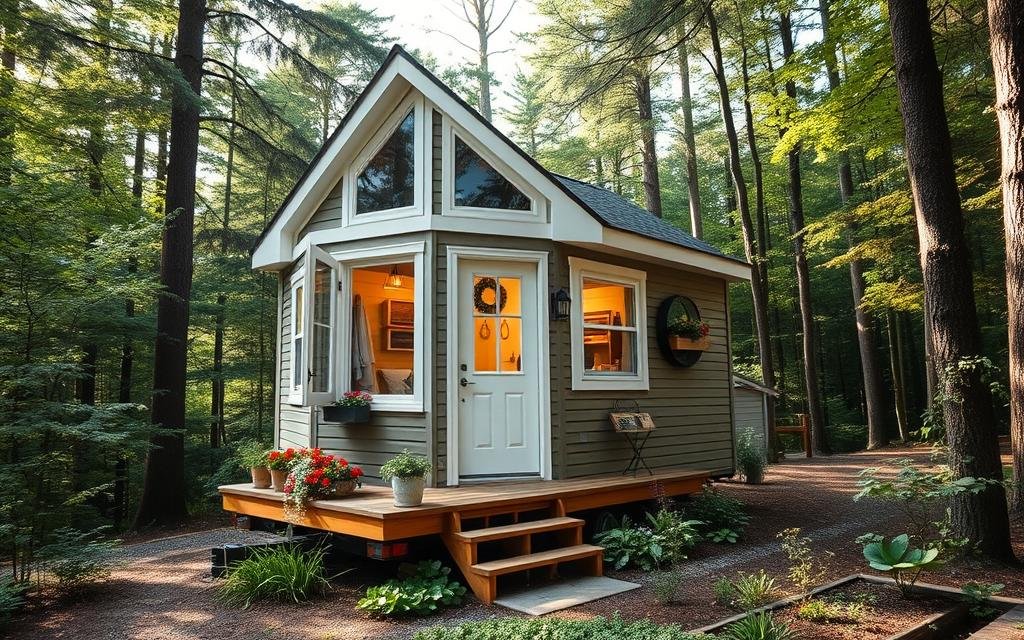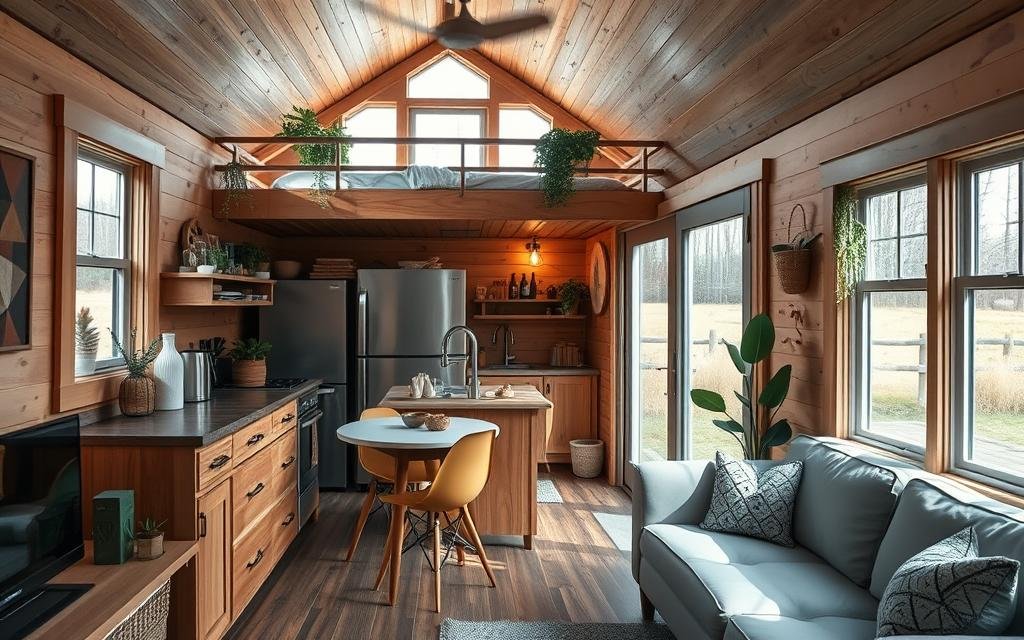Thinking about getting a tiny house? You might wonder if they can be moved easily. The answer is yes, but you need to plan well. The cost to move a tiny home can be from $150 to $5,0001. On average, it costs about $3,5001. Knowing how to transport your tiny home is key.
When moving a tiny house, think about its size and weight. Also, consider how far and where you’re going. This helps choose the right moving service, whether it’s a short or long trip1. For more info, check out websites that talk about tiny houses and moving them.
Exploring tiny houses shows how important moving them is. You need to know the costs and what’s needed. This includes permits for oversized loads, which change by state and local DOT rules1.
Key Takeaways
- Can tiny houses be easily transported? Yes, but it requires proper preparation and planning.
- Tiny house transportation costs range from $150 to $5,0001.
- The average cost to ship a tiny house is approximately $3,5001.
- Portable tiny homes can be towed by a heavy-duty pickup truck if they comply with the maximum dimensions2.
- Special permits are often required for transporting structures larger than the specified dimensions2.
- Hiring a professional mover can mitigate risks such as tire blowouts and damage to the tiny home’s undercarriage2.
Understanding Tiny House Mobility Basics
Transporting a tiny house involves several key factors. The size of your tiny house matters a lot. Tiny houses are usually under 1,000 square feet, with some as small as 400 square feet3. They are about 8 feet wide and 26 feet long on average3.
These dimensions are crucial for tiny house moving and transporting a tiny home.
There are different types of tiny houses, like those on wheels, trailers, or skids. Each type has its own transport needs. For example, houses on wheels can be towed, while trailer houses need a separate trailer. The U.S. has rules for moving tiny houses without a special permit: height, width, and length can’t exceed certain limits3.
The weight and size of your tiny house also matter for transport. Planning carefully ensures a safe move. Using sustainable materials and construction methods can also help the environment4. Knowing these basics helps plan a successful tiny house moving and transporting a tiny home process.
| Country | Average Home Size |
|---|---|
| United States | 2,600 square feet (241.55 m2) |
| United Kingdom | 818.06 square feet (76 m2) |
| France | 1,205.56 square feet (112 m2) |
By considering these factors and understanding tiny house mobility basics, you can ensure a safe and successful transporting a tiny home experience.
Essential Requirements for Moving a Tiny Home
Moving a tiny house on wheels needs careful planning and preparation. You must check local and state rules for oversized loads, which most tiny houses fall under5. This means getting the right permits, like oversize load permits, to follow moving tiny homes rules5. It’s best to hire a pro transport company that knows how to move park model homes or mobile homes5.
To make moving easy, take out or tie down all loose items and disconnect utilities before moving5. Use trailers made for moving park model homes to keep things safe and legal5. Also, make sure the trailer is balanced right with heavy-duty straps and chains to keep the home safe6. You’ll also need a truck that can tow at least 15,000 pounds to move a tiny house6.
Some important things to think about when moving a tiny house include:
- Checking local and state rules for oversized loads5
- Getting the right permits, like oversize load permits5
- Hiring a professional transport company5
- Ensuring proper weight distribution on the trailer6
By following these key steps and thinking about your tiny home’s special needs, you can have a smooth and worry-free move. This way, you’ll achieve easy tiny house mobility5.

Legal Considerations When Transporting Tiny Houses
Transporting a tiny house comes with legal hurdles. You need permits and documentation. This includes a permit for oversized loads and state-specific permits7. Your tiny house must also meet safety and building codes.
It’s vital to know the laws in your state and any others you’ll visit. About 75% of tiny home owners need permits or licenses in at least one state8. You’ll also need insurance, with costs from $100 to $300 for long-distance moves8.
Permits and Documentation
- Obtain a permit to transport an oversized load
- Secure state-specific permits as required
- Ensure compliance with safety and building codes

Understanding legal aspects helps avoid fines and issues. Tiny house towing services are available for local and long-distance moves7. Choose a service that fits your needs and budget7.
Professional vs DIY Transportation Options
When it comes to moving a tiny home, you have two main choices: hire a professional or do it yourself. Each option has its own advantages and disadvantages. The best choice for you depends on your specific needs and situation. Moving a tiny house on wheels is a complex task that requires careful planning9.
Hiring a professional transport company can give you peace of mind and ensure a safe move. But, it can be pricey, with costs ranging from $2,000 to $10,000. This depends on the distance, size of your home, and extra services needed9. On the other hand, doing it yourself can save money. But, it takes a lot of time and effort. You’ll also need the right equipment and experience to move it safely.
When choosing between professional and DIY transport, consider your tiny house’s size and weight, and the distance to move it. For example, if your home is over 8.5 feet wide, you’ll need a wide-load permit10. Also, remember the weight limit for towing a tiny house, which is up to 10,000 lbs for smaller models10.
Here are some pros and cons of each option to consider:
- Professional transport company:
- Peace of mind and safe transport
- Experienced and equipped to handle complex transports
- Can be expensive
- DIY transportation:
- Can save you money
- Requires significant time and effort
- Requires necessary equipment and experience

The choice between professional and DIY transport depends on your specific needs and situation. By considering the pros and cons of each option, you can make an informed decision. This will help you choose the best way to transport your tiny home, keeping in mind easy tiny house mobility9.
Preparing Your Tiny House for Transport
Preparing your tiny house for transport is crucial for a safe move. You must secure all interior items to prevent damage during transport. This includes furniture and appliances. Also, protect the exterior and disconnect all utilities.
Creating a safety checklist is a key step. It should cover checking the weather, securing loose items, and ensuring your tiny house is insured. Consider the size and weight of your home and any obstacles on the route.

- Securing all interior items, including furniture and appliances
- Protecting the exterior from damage
- Ensuring that all utilities are disconnected
- Creating a safety checklist
- Checking the weather forecast and route for potential obstacles
By following these steps, you can ensure a smooth transport experience for your tiny home. This will make the move stress-free for your portable and mobile tiny houses11and12.
Cost Factors in Tiny House Transportation
When you think about tiny house transportation, it’s key to know the costs involved. The distance, route, and transport type all play a big role. For short moves, it can cost $200 to $1,50013. Long moves might cost between $1,000 to $5,00013.
The cost also depends on the transport method. Towing can cost $1 to $3 per mile13. Flatbed trucks might cost $3 to $4 per mile13.
Other things can also affect the cost. The size and weight of your tiny house matter, with bigger ones costing more14. You might also need extra permits, insurance, and equipment, adding to the total cost14.
It’s smart to research these factors to plan your budget. Costs for tiny house transportation can range from $1 to $2 per mile for towing15. Moving a tiny home within the same state can cost $160 to $90015.
To understand the costs better, consider these points:
* Distance and route
* Type of transport (towing or flatbed truck)
* Size and weight of the tiny house
* Need for additional permits and insurance
* Equipment requirements
Knowing these can help you estimate the cost of transporting a tiny home and make a smart choice131415.
Best Vehicles for Towing Tiny Houses
Choosing the right vehicle to tow a tiny house is crucial. You need a heavy-duty truck that can handle the weight and size of your home. The Ford Super Duty F-450 can tow up to 37,000 pounds, and the Chevy Silverado 3500HD can tow nearly 36,000 pounds16.
When picking a vehicle, consider its towing capacity, engine type, and wheelbase. For towing, V6 or V8 engines are best, found in trucks with over 7,000 pounds towing capacity17. A longer wheelbase also helps, reducing sway by 17% with a 6-inch increase17.
Here are some top picks for towing tiny houses:
- Ford F-150: maximum towing capacity of up to 13,200 pounds16
- Chevrolet Silverado 3500HD: maximum towing capacity of nearly 36,000 pounds16
- Ford Super Duty F-450: best-in-class towing power of up to 37,000 pounds16
It’s vital to pick a vehicle that fits your needs for safe and successful tiny house transport, whether moving or not17.

Always follow the manufacturer’s towing guidelines and keep a safe distance when towing a tiny house. The right vehicle and precautions ensure a safe move for your tiny house16.
| Vehicle | Maximum Towing Capacity |
|---|---|
| Ford F-150 | up to 13,200 pounds |
| Chevrolet Silverado 3500HD | nearly 36,000 pounds |
| Ford Super Duty F-450 | up to 37,000 pounds |
Common Challenges When Moving Tiny Houses
When moving a tiny house, several challenges come up. One big one is dealing with narrow roads and low bridges. These can be tough when transporting a tiny home18. Also, bad weather can make things harder and increase damage risks, showing why easy tiny house mobility19 is key.
Some common challenges include:
- Narrow roads and low bridges
- Inclement weather
- Weight and size restrictions on roads
Planning the route carefully is vital to avoid damage18. The cost to move a tiny home varies. It depends on distance, size, and needed permits. Extra costs come up if you need pilot cars for navigation20.
To beat these challenges, team up with a trusted, experienced company in tiny house transportation18. They offer guidance and support for a safe move. Knowing these challenges and how to tackle them lets you enjoy easy tiny house mobility and the tiny house life19.
Route Planning and Navigation Considerations
When moving your tiny house on wheels, planning the route is key. You need to know about height limits, bridge weight limits, and weather. About 60% of the tiny home’s weight should be in the front for better towing21. Heavy-duty trucks and SUVs are best for towing tiny homes because they can handle more weight21.
Some places have weight limits for trailers, from 3,000 to 10,000 pounds. Knowing these limits is important21. Using tools for trailer route planning can help avoid roads with weight limits or dangers21. Tiny houses usually weigh between 4,000 to 8,000 pounds, built on trailers22.
Think about your tiny house’s size and weight when planning. They are usually 28 feet long, 8 feet wide, and weigh about 10,000 pounds23. Legal limits are 8.5 feet wide, 13.5 feet high, and 40 feet long23. Careful planning ensures a safe move of your tiny house.
Checking tire pressure and tread depth is vital. Improper tire care causes 30% of trailer accidents21. About 60% of tiny house owners have moved their homes at least once22. Knowing these tips helps in a smooth and safe move of your tiny home.
| Factor | Consideration |
|---|---|
| Height Restrictions | Avoid low bridges and overpasses |
| Bridge Weight Limits | Be aware of weight limits to avoid damage |
| Weather Conditions | Plan for inclement weather to ensure safe transport |
Time Requirements for Tiny House Transport
Understanding the time needed for tiny house moving is key for a smooth journey. You’ll need to prepare your tiny home, get permits, and ready your vehicle6. The travel time varies based on distance, route, and stops. Make sure your vehicle can tow at least 15,000 pounds6 and load distribution is right.
The cost to ship a tiny house ranges from $500 to $5,00024. Long-distance shipping starts at $1,00024, while short trips can be as low as $80024. Check your vehicle’s towing capacity, like the Ford Super Duty F-450’s 37,000 pounds24, or the Ford F-150’s 13,200 pounds24.
Plan your route well for easy tiny house transport. Consider height limits, bridge weights, and weather. Most U.S. states allow tiny houses up to 13 feet 6 inches tall6 and 8 feet 6 inches wide6. With the right planning, your move will be smooth and stress-free.
| Vehicle | Towing Capacity |
|---|---|
| Ford Super Duty F-450 | up to 37,000 pounds24 |
| Ford F-150 | up to 13,200 pounds24 |
| Chevrolet Colorado | up to 7,700 pounds24 |
Safety Measures During Transportation
When moving a tiny house, safety is key. You need a first aid kit and a fire extinguisher6. Also, a two-way radio is important to keep in touch with your team and emergency services25.
The truck towing your tiny house should have a towing capacity of at least 15,000 pounds6. The load should be 60% ahead of the axle and 40% behind6. Always check the truck’s condition, including cooling systems, brakes, and tyre pressure, before towing6.
Remember the “80% Towing Rule” to avoid overloading25. Weight distribution systems help with stability and braking, keeping control with a heavy trailer25. These steps ensure a safe move of your tiny home.
Conclusion
Starting your tiny house journey means you need to think about moving it easily26. Tiny homes are great for those who love to travel. Knowing how to move your tiny house safely and efficiently is key26.
Choosing the right way to move your tiny house is important. You can use a trailer, flatbed, or other options depending on its size and weight26. Always follow local laws when moving your tiny house. Getting the right permits is crucial for a legal move26.
Using professional movers can make your tiny house move safer and faster26. They have the skills and tools needed for a smooth move. Make sure to secure loose items and check the vehicle before moving26.
Professional movers can save you a lot of time, making your move quicker26. They show that tiny houses can be moved often, proving they are truly mobile. This makes them perfect for those who love to travel.
This article has given you the tools to move your tiny house with confidence26. You can move it yourself or hire professionals. The most important thing is to plan well, follow the rules, and keep safety in mind. With the right steps, your tiny house can be a mobile and flexible home. It will let you explore new places and enjoy the freedom of the tiny house life.



